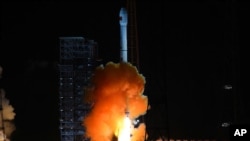Earlier this month, we reported on a rocket booster that is on a path to strike the moon in early March. Since that report, the space expert who first observed the object has said the booster was misidentified.
It was first thought that the booster was left over from a SpaceX Falcon 9 rocket used to help deploy a climate satellite in 2015. Now, it is believed to be a booster from a Chinese rocket launched in 2014.
The path of the booster was first observed by American astronomer Bill Gray. He is the creator of Project Pluto, based in the northern U.S. state of Maine. He develops and sells software that can track the path of different space objects, including leftover ones known as space junk.
Gray says all his data shows that the rocket will hit the far side of the moon – the side that faces away from Earth – on March 4. He received wide attention for identifying the booster and closely tracking its path. But Gray recently said new evidence had shown that his identification was most likely not correct.
“We now have good evidence that it is actually 2014-065B, the booster for the Chang’e 5-T1 lunar mission,” Gray said in a statement on his website. Chang’e 5-T1 was a robotic spacecraft sent on a test mission to circle the moon and return to Earth in October 2014.
Gray made his first identification back in 2015. He explained that it was based on evidence that the SpaceX booster had “passed close by the moon on February 13, 2015, two days after it was launched.”
Gray said he started taking another look into the booster’s identify after receiving an email from Jon Giorgini, who works for the American space agency NASA. Giorgini, an engineer with NASA’s Jet Propulsion Laboratory (JPL), had examined NASA tracking data and said it suggested the SpaceX rocket did not pass close to the moon.
So, Gray reconsidered his earlier observations and looked at the latest evidence. He decided that his first identification did seem to be incorrect. Now, Gray says he is effectively “persuaded” that the object is a rocket booster from the Chang’e 5-T1 spacecraft.
The booster’s expected strike on the moon has also been confirmed by astrophysicist Jonathan McDowell of the Center for Astrophysics. He reacted to the misidentification on Twitter.
“So, the rocket about to hit the Moon, it turns out, is not the one we thought it was,” he wrote. “This (an honest mistake) just emphasizes the problem with lack of proper tracking of these deep space objects.”
Researchers at the University of Arizona recently announced they had also confirmed the booster most likely came from the Chinese rocket. The team – from the university’s Space Domain Awareness laboratory – said it confirmed the identity by closely observing the object’s composition and paint.
NASA has also confirmed the expected strike. A spokeswoman for the space agency told the French Press Agency, AFP, that the event can be “an exciting research opportunity.” She said NASA is interested in studying the crater expected to be created by the hit. But the spokeswoman added that that is likely to be a difficult process and it could take “weeks to months” to find the crater.
In the past, spacecraft have been crashed into the moon on purpose for scientific experiments. But this is likely the first unplanned strike to be identified in this way.
I’m Bryan Lynn.
Bryan Lynn wrote this story, based on reports from Bill Gray, the University of Arizona, Twitter and NASA.
We want to hear from you. Write to us in the Comments section, and visit our Facebook page.
____________________________________________________________
Words in This Story
boost – v. to push or shove up from below
track – v. to record the progress of development of something
mission – n. an important project or trip, especially involving space travel
persuade – v. to make someone agree to do something by presenting arguments and evidence
emphasize – v. to show that something is especially important or needs special attention
proper – adj. correct or suitable
composition – n. the parts, substances and other things that something is made of
opportunity – n. a situation in which it is possible for a person to do something
crater – n. a round hole made by an explosive force such as a bomb or an object falling from the sky








